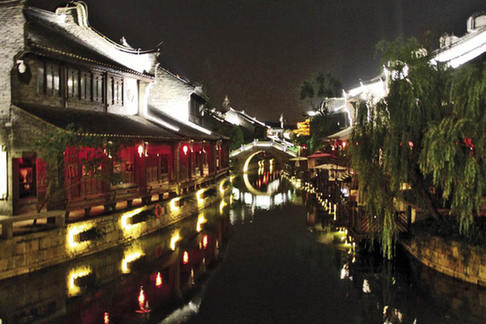Conservation and Development of the Grand Canal Shandong Section
By GAO XIN
The Shandong section of the Grand Canal’s successful application for World Heritage listing augurs an immense conservation project that will construct eco-cities and beautiful villages, hence promoting rural tourism and bringing inestimable benefits to local residents.
The Grand Canal gained World Heritage status, so becoming China’s 46th World Heritage site, on June 22. The decision was announced at the 38th session of the UNESCO World Heritage Committee in Doha, Qatar. An important component of the Grand Canal’s application, the Shandong section is now the province’s fourth item of world cultural heritage, along with Mount Tai, the Temple and Cemetery of Confucius and the Kong Family Mansion, and the Great Wall of Qi.
|
 |
|
The Grand Canal bustles once more in Tai’erzhuang Ancient Town. |
North to South
Running from Beijing in the north to Hangzhou in the south, the Grand Canal flows through two municipalities and four provinces – Beijing, Tianjin, Hebei, Shandong, Jiangsu, and Zhejiang, and connects five river systems, namely the Haihe River, Yellow River, Huaihe River, Yangtze River and Qiantang River. The World Heritage Committee defines the canal as the world’s longest and oldest artificial watercourse and largest, most extensive pre-Industrial Revolution civil engineering project.
A review of the canal’s evolution gives some idea of the significance of its role in regional economic development and cultural exchanges between North and South China, most particularly in the industrial and agricultural progress along its banks. Different from other cultural heritages, after more than two millennia of consistent improvements the canal still performs the main functions of transportation, irrigation, and drawing off floodwater. It is consequently a “living heritage.”
Throughout the canal’s development history the Shandong section has been the most difficult to navigate and so demanded the most complex maintenance engineering technology. The Shandong section has a total length of 643 km. It runs through the five cities of Zaozhuang, Jining, Tai’an, Liaocheng and Dezhou. Its Huitong Canal project and the related scheduling and management of water resources stand testament to the Grand Canal’s remarkable technical achievements in water transportation. The cities along the canal of Dezhou, Linqing, Dongchang, Jining, and Tai’erzhuang are of strategic trade and transport importance. Known as the Grand Canal city, Jining was site of the canal’s top regulatory agency during the Yuan, Ming, and Qing dynasties.
The Shandong section encompasses eight of the Grand Canal’s total 27 reaches, and 15 of its total 58 heritage sites. The Shandong heritage area, covering 16,603 hectares and with a buffering area of 29,501 hectares, is site of the remains of many water conservancy projects. It consequently showcases the technological creativity entailed in the traditional canal system – a main factor of its world heritage application.
Concerned Conservation
Starting in misty Weishan Lake, Tai’erzhuang Canal meanders east through vast southern Shandong to the Grand Canal’s middle section in Jiangsu Province. The 42.5-km-long canal is its sole east-west section. In the past it was little more than a drainage ditch and garbage dump for the shanty towns along it.
